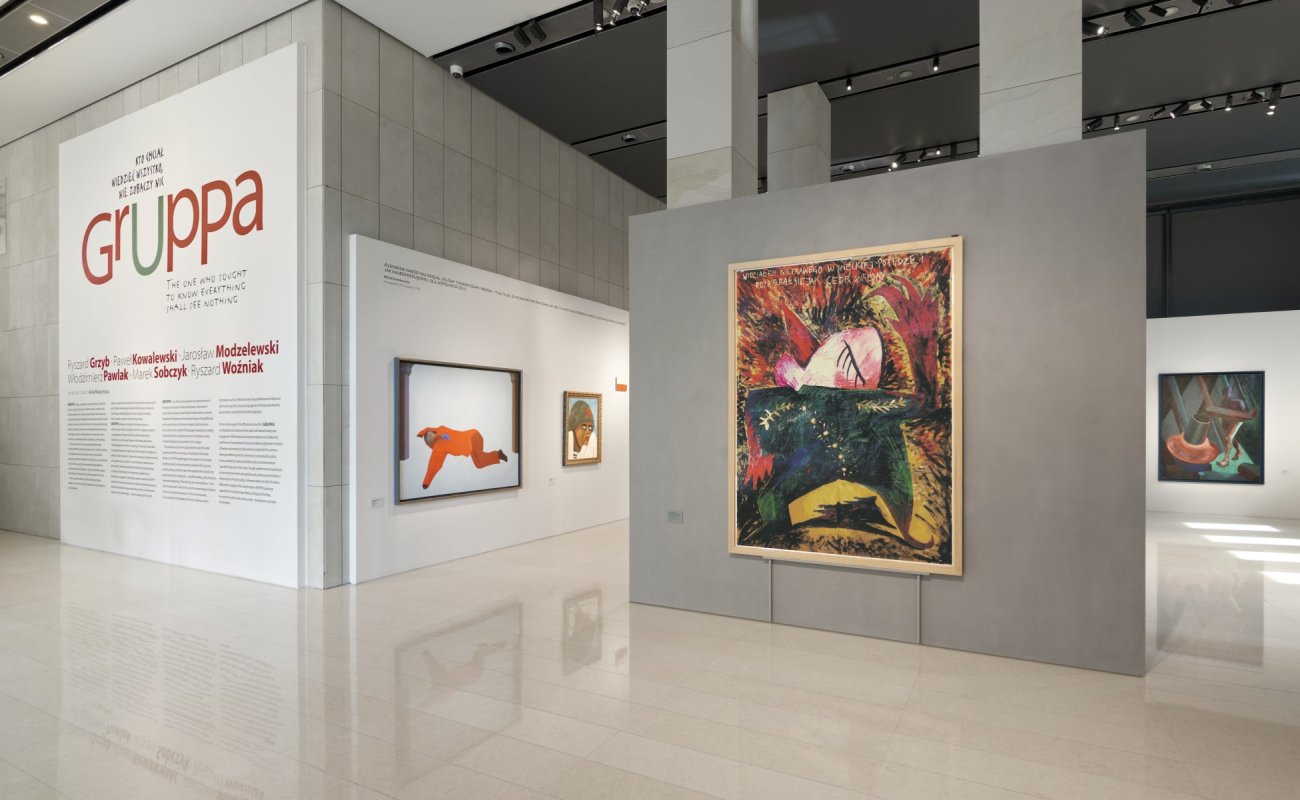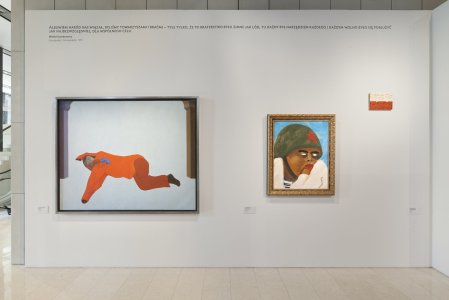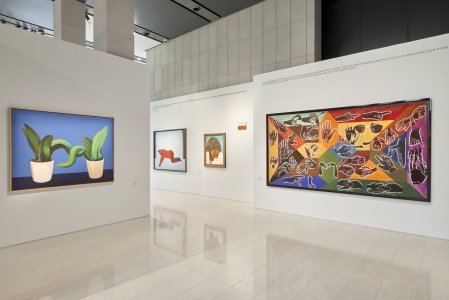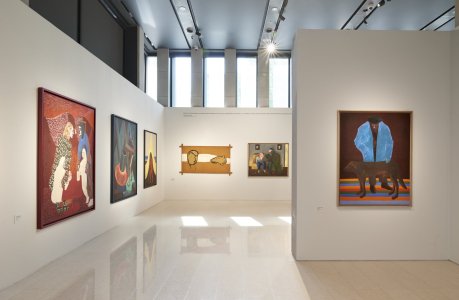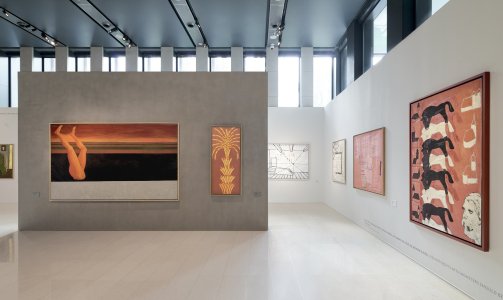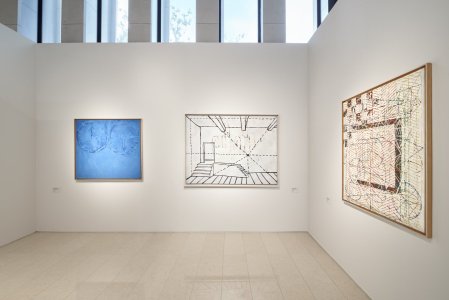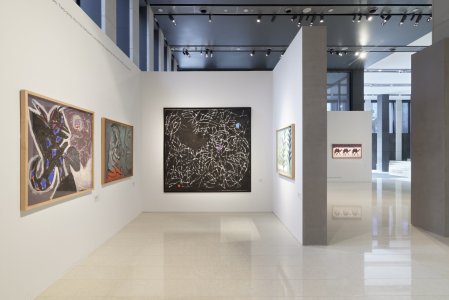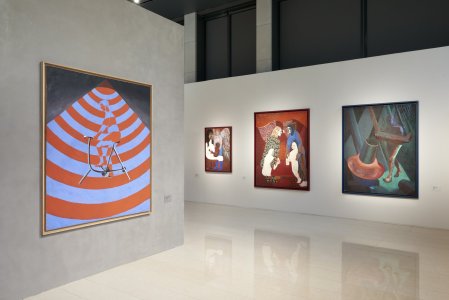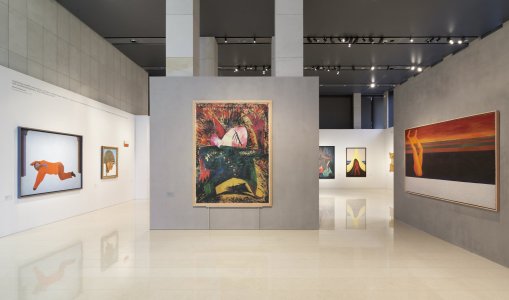GRUPPA absurdly attempts to redeem the world with its three favorite colors: green, black, and red. Look at me (GRUPPA thinks, while painting) here’s my whole private, personal art.
This is my body. This is my soul. Come in and take of me, all of you. This seeming openness turns out to be a way of fending off the emptiness of painting, and the absurdity of making art at all.
(…)
There is something in GRUPPA’s words and pictures that no one truly believes. We meet the greatest tragedies and the most complete joy in a kind of dazed disbelief. We refuse to trust that our creative pessimism, our doubt, could ever lead to any change whatsoever. We try to paint all of it, for as long as we still have the strength left for artistry. (…)
The one who sought to know everything shall see nothing.
Włodzimierz Pawlak
"Oj, dobrze już” [1986] no 6
GRUPPA – one of the most charismatic and expressive artistic formations of the 1980s in Poland and broadly in the whole of Central Eastern Europe. Ryszard Grzyb, Paweł Kowalewski, Jarosław Modzelewski, Włodzimierz Pawlak, Marek Sobczyk i Ryszard Woźniak are the painters who in the historic moment of political tension and social insecurity called for the language of expression by creating a drastically honest and daring reaction to the martial law reality of national stagnation and surrender of civic courage.
The exhibition at Spectra Art Space presents mainly the works created by GRUPPA artists during a crucial period in their career. Members of GRUPPA rebelled against the aesthetics of minimalism by offering violent, emotional painting, saturated with color, irony and the grotesque and at the same time expanded their activities into performative forms of expression - manifesto readings, demonstrations, improvised happenings. Their paintings are visual manifestos - in the spirit of “personal art,” which at the same time remain deeply immersed in the social context and experience of their contemporaries. The six students of the Academy of Fine Arts in Warsaw, alumni of professors such as Stefan Gierowski, Ryszard Winiarski and Rajmund Ziemski, among others, found a language of art that proved extremely apt and timely, making their formation legendary. Through the mutual cultural codes that united them – their literary, musical, cinematic and philosophical fascinations - GRUPPA's painting was legible and communicative, becoming an identity and formative experience for an entire generation. As Jarosław Modzelewski recalled in an extensive interview published in 2013: " GRUPPA was a place where meetings of various idols took place. Both Gombrowicz and Malewicz, as well as Strzemiński or Wróblewski would come to visit. One could say that in that way GRUPPA consisted of more people. (...) It seems to me that this “renewal” referred to tradition, to the roots; to the fact that behind us there were people who made art before and that we owe them something. (...) Intellectually and formally we are very strongly connected to tradition. GRUPPA was a very emotional environment so these voices from the afterworld were also intense and emotional."
Active on the margin of the official discourse of art, GRUPPA contributed to the Polish art of the 1980’s with radical honesty and engagement. While Poland was living the experience of Solidarność and the rest of Central-Eastern Europe was balancing between the desire of freedom and repression, their work resonated with the common feeling and offered a precise commentary to everyday life, politics, history and identity. National symbols, myths, sometimes almost “sanctities” featured in their works, though undermined and questioned by the artists themselves were paradoxically unifying and reminded us of the burden of Polish tradition. Moments before the fall of the Berlin Wall and the collapse of the Soviet empire, GRUPPA's paintings captured the emotional map of fears and hopes of the Poles. For when the nation calls, artists answer - they become comrades. And brothers.
In the Starak Collection, for over fifteen years GRUPPA has been consistently representing an exemplary image of the generation's identity. Its presence in the collection is a natural development of the idea of painting by Andrzej Wróblewski who was the spiritual patron of the formation. He was their point of reference. Figurative and engaged painting under the auspices of the slogan “Art must act!” as an imperative, became a valuable tool for GRUPPA members’ reaction to reality.
Among the works presented at the exhibition there is one of most emblematic paintings by Marek Sobczyk - the monumental canvas “Where They Still Fight in Poland” from 1988. The painting, created at the dawn of political transformation, symbolically exposes the absurdity of violence and the legacy of conflicts that weighed on the world in the 1980s. The exhibition particularly resonates with Paweł Kowalewski's “Mon Cheri Bolshevique” from 1984 - a work set in the tragic pa-radox of Polish-Russian relations: full of irony, it also constitutes a warning balancing between fascination with Russian culture and spirituality and the awareness of its brutal imperial heritage. On the side there are gouaches by Ryszard Grzyb, full of energy and sharp humor with literary titles as carriers of multi-layered meanings. Their ironic form brings a counterpoint to the silence and tension of Jarosław Modzelewski's paintings, such as the monumental “Dream with a Gun.” A figure in a red suit with a gun covering his face, reduced almost to a sign, evokes the spirit of de-individualized figures from Wróblewski's “Executions,” juxtaposing the intimacy of an individual nightmare with universal fear. In Ryszard Woźniak's “Builder,” of a scale of a fresco filled with intense color, there is a figure of man “upside-down” - participating, perhaps, in the construction of a system the sense of which he does not understand and the logic of which he does not control. The image becomes an accurate commentary on the role of the artist and the citizen in the world. “The Moment When Man and Dog Feel the Same Pain of Existence” by Włodzimierz Pawlak from 1986 is a painting in which the outlines of two heads – of a human and of a dog - painted in black dripping paint meet against a background of a white strip painted with a roller evoking the brutalist aesthetics of the Polish People’s Republic censorship. It’s the artist’s deliberate reference to the slogans of the opposition of those days which the state Police was covering with paint, it is also his existential manifesto.
The exhibition at Spectra Art Space is also another meeting of GRUPPA members with Anna Muszyńska as curator. They first collaborated jointly on the major and legendary exhibition "We Plead Guilty. We Ask for Forgiveness. We Promise to Improve" at the Program Gallery in Warsaw, Poland, in 2002, the 20th anniversary of GRUPPA's first joint appearances. That exhibition shed a new light on the figuration of the 1980s in the context of the art of the early 21st century, while the current one is a presentation of classics with an established and undeniable position in the history of Polish art.
GRUPPA is one of the most important artistic formations in Poland of the 1980s established in 1982 by six students of the Academy of Fine Arts in Warsaw: Ryszard Grzyb, Paweł Kowalewski, Jarosław Modzelewski, Włodzimierz Pawlak, Marek Sobczyk and Ryszard Woźniak. Their first joint exhibition entitled “Forrest, Mountain, Cloud,” took place on January 14, 1983 in the Warsaw studio Dziekanka which constituted a decisive reaction to the proclamation of martial law in Poland and was a manifest expression of their artistic revolt. GRUPPA was intensively active for a decade until the beginning of the 90s. Their work was characterized by expressive painting filled with irony and the grotesque in a response to the absurdities of the Polish People’s Republic’s reality. GRUPPA’s major exhibitions such as: “Forrest, mountain, cloud,” Dziekanka, Warsaw1983, “Prime Minister’s Mother,” Warsaw, 1984, “Woman Runs Away with Butter,” Warsaw, 1984, “The Art of Admiration,” Warsaw, 1985, “Tonight Only My Love,” Lublin, 1985, “Boredom is Your Hero You Bums”, Poznań, 1986, “Grupa -Gruppen”, Sztokholm, 1987, “Avanguardia polacca. Esposizione dell’arte indipendente polacca, Centro Direzionale Colleoni, Agrate Brianza, Italy, 1987; “Kuda Gierman, Gruppenkunstwerke”, Kassel, Germany, 1987; “Grupa. Just After Easter”, Dziekanka, Warsaw, 1992, „Gruppa” – Zachęta Narodowa Galeria Sztuki, Warsaw, 1992/1993, "We Plead Guilty. We Ask for Forgiveness. We Promise to Improve" Program Gallery, Warsaw, 2002. In 2023 GRUPPA’s first monography was published by Jerke Art Foundation and premiered at the Museum Of Modern Art in Warsaw.
Anna and Jerzy Starak own one of the most important collections of Polish contemporary art in Poland. As benefactors, they have been actively supporting cultural institutions and major events for over fifteen years. Since 2013 within the framework of the Spectra Art Space of the Starak Family Foundation they have been patrons of the exhibition program in the Foundation’s headquarters at 6, Bobrowiecka Street in Warsaw. Since 2016 the Starak Family Foundation has been regularly organizing exhibitions of Polish art at the Venice Biennale. In June 2024 Anna Woźniak-Starak and Jerzy Starak in recognition of their contribution to reinforcing and developing the international presence of Polish art and significant cultural patronage and support for young female and male artists, were awarded gold medals “Meritorious to Culture Gloria Artis” by the Minister of Culture and National Heritage Hanna Wróblewska.
EXHIBITION CATALOGUE - please download pdf.
GRUPPA.
Kto chciał wiedzieć wszystko, nie zobaczy nic.
The One Who Sought to Know Everything Shall See Nothing.
14 June - 26 October 2025
curator: Ania Muszyńska
curatorial team: Magdalena Marczak-Cerońska, Kama Kieremkampt
Open everyday | 10:00 a.m. - 6:00 p.m..
Wedensdays 10:00 a.m. - 8:00 p.m.
Free admission
Starak Family Foundation | Spectra Art Space
Bobrowiecka 6 | Warsaw
www.starakfoundation.org

